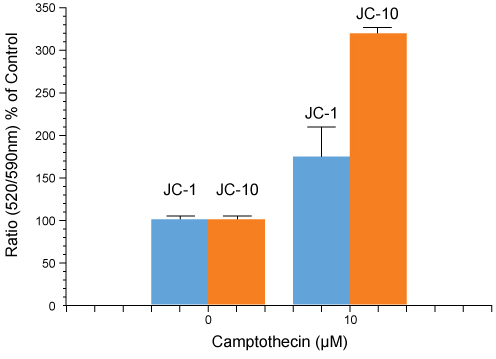JC-10 (high purity)
| Code | Size | Price |
|---|
| AG-CR1-3600-M001 | 1 mg | £70.00 |
Quantity:
| AG-CR1-3600-M005 | 5 mg | £195.00 |
Quantity:
Prices exclude any Taxes / VAT
Overview
Regulatory Status: RUO
Shipping:
-20°C
Storage:
-20°C
Images
Documents
Further Information
Alternate Names/Synonyms:
Enhanced JC-1
Appearance:
Deep blue to violet solid.
EClass:
32160000
Form (Short):
liquid
Handling Advice:
Keep cool and dry.Protect from light.
Long Description:
Chemical. MW: ~600. JC-10 is superior analog of JC-1, useful for determining mitochondrial membrane potential (MMP) in cells by flow cytometry, fluorescence microscopy and in microplate-based fluorescent assays. JC-10 is a cationic, lipophilic dye that accumulates in mitochondria of cells with a polarized mitochondrial membrane, selectively generating an orange J-aggregate emission profile (lambdaex = 540 nm/lambdaem = 590 nm) in healthy cells. Upon cell injury or cell death, as membrane potential decreases, which results in the failure to retain JC-10 aggregates in the mitochondria and JC-10 monomers are generated resulting in a shift to green emission (lambdaex = 490 nm/lambdaem = 525 nm). JC-10 shows improved solubility compared to JC-1 in aqueous media and an ability to detect subtler changes in mitochondrial membrane potential loss. JC-10 allows for qualitative visualization (shift from orange to green fluorescence) and quantitative detection (fluorescence intensity ratio) of mitochondrial membrane potential changes. Wavelength Maxima: lambdaex = 510 nm | lambdaem = 525 nm.
Molecular Weight:
~600
Other data:
Application Protocols for JC-1: See literatures 1-3.
Package Type:
Vial
Product Description:
JC-10 is superior analog of JC-1, useful for determining mitochondrial membrane potential (MMP) in cells by flow cytometry, fluorescence microscopy and in microplate-based fluorescent assays. JC-10 is a cationic, lipophilic dye that accumulates in mitochondria of cells with a polarized mitochondrial membrane, selectively generating an orange J-aggregate emission profile (lambdaex = 540 nm/lambdaem = 590 nm) in healthy cells. Upon cell injury or cell death, as membrane potential decreases, which results in the failure to retain JC-10 aggregates in the mitochondria and JC-10 monomers are generated resulting in a shift to green emission (lambdaex = 490 nm/lambdaem = 525 nm). JC-10 shows improved solubility compared to JC-1 in aqueous media and an ability to detect subtler changes in mitochondrial membrane potential loss. JC-10 allows for qualitative visualization (shift from orange to green fluorescence) and quantitative detection (fluorescence intensity ratio) of mitochondrial membrane potential changes. Wavelength Maxima: lambdaex = 510 nm | lambdaem = 525 nm.
Purity:
>98% (HPLC)
Solubility Chemicals:
Soluble in water or DMSO.
Transportation:
Non-hazardous
UNSPSC Category:
Fluorescent Reagents
UNSPSC Number:
12171500
Use & Stability:
Stable for at least 2 years after receipt when stored at -20°C.
References
Flow cytometric analysis of mitochondrial membrane potential using JC-1: A. Cossarizza & S. Salvioli; Curr. Protoc. Cytom. Chapter 9, Unit 9.14 (2001) (JC-1 Protocol) | Polychromatic analysis of mitochondrial membrane potential using JC-1: E. Lugli, et al.; Curr. Protoc. Cytom. Chapter 7, Unit 7.32 (2007) (JC-1 Protocol) | Labeling mitochondria with JC-1: B. Chazotte; Cold Spring Harb. Protoc. 2011, (2011) (JC-1 Protocol) | Reactive oxygen species in unstimulated hemocytes of the pacific oyster Crassostrea gigas: A mitochondrial involvement: L. Donaghy, et al.; PLoS One 7, e46594 (2012) | Improving anticancer efficacy of (-)-epigallocatechin-3-gallate gold nanoparticles in murine B16F10 melanoma cells: C.C. Chen, et al.; Drug Des. Dev. Ther. 8, 459 (2014) | Calmodulin antagonists induce cell cycle arrest and apoptosis in vitro and inhibit tumor growth in vivo in human multiple myeloma: S. Yokokura, et al.; BMC Cancer 26, 882 (2014) | Toxicology of ZnO and TiO2 nanoparticles on hepatocytes: impact on metabolism and bioenergetics: C. Filippi, et al.; Nanotoxicology 9, 126 (2015) | Neurotoxicity of a pyrethroid pesticide deltamethrin is associated with the imbalance in proteolytic systems caused by mitophagy activation and proteasome inhibition: T. Hirano, et al.; Toxicol. Appl. Pharmacol. in press (2021) | Chemically Defined Xeno- and Serum-Free Cell Culture Medium to Grow Human Adipose Stem Cells: S. Panella, et al.; Cells 10, 466 (2021)
Related Products
| Product Name | Product Code | Supplier |
|---|



